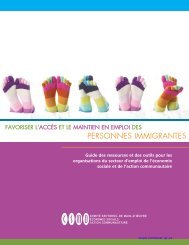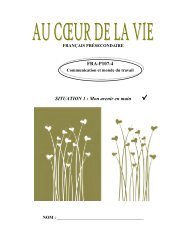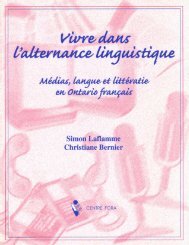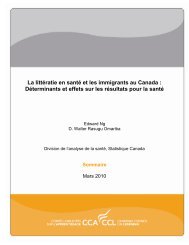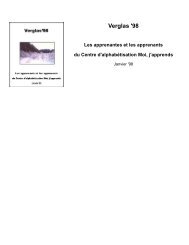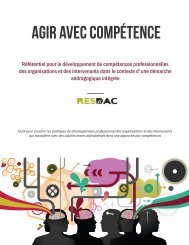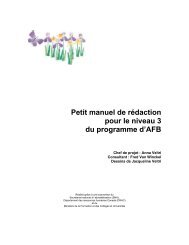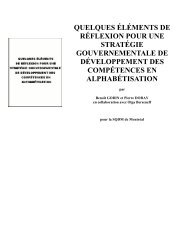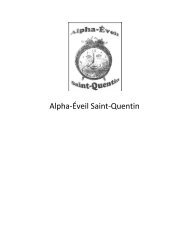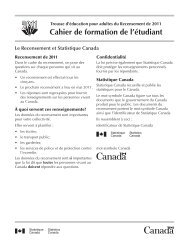Les pratiques et défis de l'évaluation en ligne - Base de données en ...
Les pratiques et défis de l'évaluation en ligne - Base de données en ...
Les pratiques et défis de l'évaluation en ligne - Base de données en ...
You also want an ePaper? Increase the reach of your titles
YUMPU automatically turns print PDFs into web optimized ePapers that Google loves.
80168 Bunn, D. N., Caudill, S. B. <strong>et</strong> Gropper, D. M. (1992). “Crime in the classroom: An economic analysis ofun<strong>de</strong>rgraduate stu<strong>de</strong>nt cheating behavior”. Journal of Economic Education, vol. 23 (Été), pages 197-207, cités parGrivalja <strong>et</strong> al. (2006).169 Whitley, B. E. (1998). Op. cit.170 Ger<strong>de</strong>man, R. (2000). Aca<strong>de</strong>mic Dishonesty and the Community College. ERIC clearinghouse for CommunityColleges, Los Angeles, CA.171 Jordan, A. E. (2001). Op. cit.172 En s‟appuyant notamm<strong>en</strong>t sur: Un<strong>de</strong>rwood, Jean; Szabo, Attila (2003). “Aca<strong>de</strong>mic off<strong>en</strong>ces and e-learning:individual prop<strong>en</strong>sities in cheating”. British Journal of Educational Technology. Vol. 34, no 4, pages 467-477.173 Whitley, B. E. (1998). Op. cit.174 Haines, V. J.; Diekhoff, G. M.; LaBeff, E. E.; Clark, R. E. (1986). “College cheating: Immaturity, lack ofcommitm<strong>en</strong>t, and neutralizing attitu<strong>de</strong>”. Research in Higher Education. Vol. 25, no 4, pages 342-354 <strong>et</strong> Diekhoff, G.M.; LaBeff, E. E.; Clark, R. E.; Williams, L. E.; Francis, B., <strong>et</strong> Haines, V. J. (1996). “College cheating: T<strong>en</strong> years later”.Research in Higher Education, vol. 37, no 4, pages 487-502, cités dans Grijalva <strong>et</strong> autres (2006).175 Smith, A. (2005). A comparison of traditional and non-traditional stu<strong>de</strong>nts in the frequ<strong>en</strong>cy and type of self-reportedaca<strong>de</strong>mic dishonesty. Paper pres<strong>en</strong>ted at the 25th Annual Great Plains Stu<strong>de</strong>nts’ Psychology Conv<strong>en</strong>tion, Omaha,NE, cité dans Stuber-Mcew<strong>en</strong> (2009).176 Du Webinaire : Plagiarism in the Digital Age: Voices from the Front Lines: What’s Happ<strong>en</strong>ing in High SchoolsToday? 18 novembre 2009 sur Plagiarism.org.177 Soto, J. G.; Anand S. <strong>et</strong> E. McGee. (2004). « Plagiarism Avoidance: An empirical study examining teachingstrategies », Journal of College Sci<strong>en</strong>ce Teaching. Vol. 33, no 7, juill<strong>et</strong>-août, pages 42-48.178 Dirks, M. (1998). “How is Assessm<strong>en</strong>t Being Done in Distance Learning?” Paper pres<strong>en</strong>ted at the NAU/web.98confer<strong>en</strong>ce, cite dans Lanier (2006).179 L‟inclusion <strong>de</strong>s par<strong>en</strong>ts était notamm<strong>en</strong>t suggérée lors du Webinaire : Plagiarism in the Digital Age. Op. cit..180 De : « Plagiat : Travailler c‟est trop dur, mais tricher c‟est pas beau… ». Le blogue <strong>de</strong> Skolan<strong>et</strong>, avril 2009.181 Dans : « Une réflexion fondam<strong>en</strong>tale sur les <strong>pratiques</strong> <strong>de</strong> plagiat à l'Université », mai 2009.182 Par exemple, dans les programmes <strong>de</strong> sports au Collège <strong>de</strong> Loughborough (JISC, 2010).183 Voir : Compét<strong>en</strong>ces informationnelles, définition <strong>de</strong> 2004.184 Dans « Plagiat électronique : on passe à l'action dans les collèges », Bull<strong>et</strong>in Clic, 2010.185 CEFRIO.(2009). Rapport-synthèse sur la génération C.186 Hard, S. F., Conway, J. M., <strong>et</strong> Moran, A. C. (2006). Op. cit.187 Dans : Timothy R. Austin. (2007), Op. cit.188 Voir le site Pour <strong>en</strong> finir avec le plagiat <strong>de</strong> son Service <strong>de</strong> souti<strong>en</strong> à la formation.189 L‟Activité <strong>de</strong> perfectionnem<strong>en</strong>t <strong>de</strong> l‟APOP : L’ère du numérique <strong>et</strong> le plagiat : comm<strong>en</strong>t traiter la question <strong>et</strong>développer <strong>de</strong>s attitu<strong>de</strong>s éthiques chez les étudiantes <strong>et</strong> les étudiants.190 Timothy R. Austin. (2007), Op. cit.191 Dans : « Étudier, rédiger, plagier, tricher, empêcher la triche ou ne pas tricher. Des ressources ».192 En étant consci<strong>en</strong>t toutefois qu‟on peut prés<strong>en</strong>ter verbalem<strong>en</strong>t un travail plagié <strong>de</strong> façon adéquate. À ce suj<strong>et</strong>, voirparticulièrem<strong>en</strong>t : « Profession : nègre <strong>de</strong> fac ». Café Babel, juin 2009.193 Dans : « À trop évaluer les élèves, on les inciterait à tricher », Cyberpresse, 2009.194 Dans “Putting our i<strong>de</strong>as of assessm<strong>en</strong>t to the test” <strong>de</strong> ESchool News, septembre 2010.195 À ce suj<strong>et</strong>, le JISC (2007 écrit que : “a vari<strong>et</strong>y of ways of verifying a candidate’s i<strong>de</strong>ntity is likely to be nee<strong>de</strong>d,regardless of the mo<strong>de</strong> of assessm<strong>en</strong>t. Individual stu<strong>de</strong>nt logins, backed up by photographic and other forms ofi<strong>de</strong>ntification – including smart cards, additional co<strong>de</strong>s and passwords or biom<strong>et</strong>rics, where appropriate – tog<strong>et</strong>herwith training for e-invigilators”.196 Dans “A Professor‟s Review of Online Cheat She<strong>et</strong>s” du New York Times du 15 septembre 2010, Roy Furchgottrelève plusieurs services <strong>de</strong> ce g<strong>en</strong>re. Par exemple, CramCasts <strong>de</strong> CliffsNotes, offre <strong>de</strong>s fichiers audio <strong>de</strong> 3 à 5minutes qui donn<strong>en</strong>t un aperçu d‟un livre. SparkNotes, propriété <strong>de</strong> Barnes & Noble <strong>et</strong> Shmoop sont <strong>de</strong>s servicesconcurr<strong>en</strong>ts.197 Blog <strong>de</strong> Francis Pisani. Op. cit.198 Il s‟agit d‟une notion apparue dans les années soixante. Wikipedia cite à c<strong>et</strong> égard Roland Barthes, écrivant que« tout texte est un intertexte ; d'autres textes sont prés<strong>en</strong>ts <strong>en</strong> lui à <strong>de</strong>s niveaux variables, sous <strong>de</strong>s formes plus oumoins reconnaissables : les textes <strong>de</strong> la culture antérieure <strong>et</strong> ceux <strong>de</strong> la culture <strong>en</strong>vironnante ; tout texte est un tissunouveau <strong>de</strong> citations révolues.»199 Dans: Lebrun, Marcel. 2002. Théories <strong>et</strong> métho<strong>de</strong>s pédagogiques pour <strong>en</strong>seigner <strong>et</strong> appr<strong>en</strong>dre: quelle place pourles TIC dans l'éducation? Bruxelles: A. <strong>de</strong> Boeck.200 Varvel, V., Jr. (2005). Honesty in online education. Pointers and Clickers. Vol. 6, no 1, pages 1-20.201 Kelley, K. <strong>et</strong> Bonner, K. (2005). « Digital text. Distance education and aca<strong>de</strong>mic dishonesty: Faculty andadministrator perception and responses”. Journal of Asynchronous Learning N<strong>et</strong>work, vol. 9, pages 43-52, dansREFAD Pratiques <strong>et</strong> <strong>défis</strong> <strong>de</strong> l’évaluation <strong>en</strong> <strong>ligne</strong> 2011



